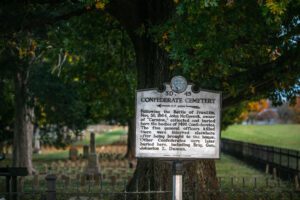Recently, I decided to take a self-guided tour of a few of our Civil War battlefield parks in Franklin; Eastern Flank and Carter Hill. Since I once was the Research Historian for the Tennessee Civil War National Heritage Area, touring these historic places was like going on a trip I had taken before but with fresh perspective and remembrance of what it took to reclaim these sacred landscapes from development. And as I walked the trails, read the Civil War Trails markers, I found myself reflecting on the realities that faced preservationists in Franklin twenty plus years ago. Saving land from development (which some thought was a ridiculous idea!) to preserve the Franklin battlefield – its cultural landscape – for future generations. Today, the laborious and tenacious work of many is now preserved for those who are here today and for those who will come tomorrow. So, with that in mind, what does our future hold?

Historic preservation is not so much about the past but about the future. With that in mind, what future do we want? Buildings do not preserve buildings. People do. Green spaces do not preserve green spaces. It’s people who preserve and protect green spaces. With the ever-increasing reality of density developments being a part of rural landscapes or encroaching upon historic neighborhoods, it takes a community to stand up and speak out, advocating for green space or smart, well-planned developments.
The fragility of resources should never be taken for granted. Preservation is not a given. One thing I’ve noticed in conversations recently is that preservation is not about preserving buildings, it is about preserving places. Quite frankly, it should not just be about a house. Rather, preservation must be about the whole.
With so many locals and newcomers putting down roots in Franklin, particularly within the Mack Hatcher corridor, the impressive growth taking hold in Williamson County, including Franklin, is due in large part to people spreading the word about our vibrant communities and the remarkable quality of life surrounding them – a quality of life that may only be sustained through careful, intentional planning and viable infrastructure.

Why land from development? All one must do is look to cities like Atlanta, or even just eighteen miles north of Nashville, to acknowledge the stark realities of unfettered growth. And while Franklin can and should grow, we should all take an active role in advocating for its future. I often hear from newcomers to Franklin say, “we fell in love with the rolling green hills of Williamson County…. we drove down Franklin Road into Main Street and knew we had found our forever community…. or we love how Franklin cares deeply for its history and historic places.” The one commonality is that people take notice of the nearly six decades of intentional, daily work to save all our historic places.
It’s easy to cherry-pick what we each think is or isn’t worthy to advocate for in our community. I mean, let’s face it. We all have things to do each day and the last thing most of us want to do is to spend the later part of the afternoon or evening at a city or county meeting. However, may I issue a challenge to you. Instead of focusing on the well-known “Not in My Backyard” become an advocate, using your voice (and encouraging your neighbors too) to steward “Quality in My Backyard.” Shifting our mindset from “it’s not my street, it’s not my problem,” to “it’s my community, it’s our quality of life” turns passive into active.
In 2005, preservationists and civil war historians knew saving the Franklin battlefield was necessary. The challenge was simple but financially steep. Five million dollars. But what would happen to the green space along Lewisburg Pike if 120 homes were to be built on 110 acres? Those on the frontlines, including the Heritage Foundation, knew that if it was not done right, there was no Plan B. It would have been lost forever.

As growth continues its current trajectory, Franklin is a critical crossroads. Connecting people with places is where we, as preservation advocates, may forge a new path with more people who may be unaware of the realities facing our historic and cultural resources. So yes, people, we must champion our historic, cultural, and even natural resources, advocate for positive, architecturally sensitive developments within our historic districts, and appeal for creating a sense of place, purpose, and community. It is imperative to protect the future of historic preservation and connect people – all people – who can take an active role in safeguarding our cultural heritage. For us to chart the course of the preservation we want to see in Franklin and Williamson County.